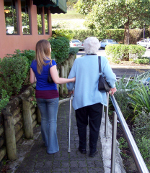Living With Osteoporosis
Published by Stephen on November 29, 2009 Under fall prevention Aging is the term used to describe growing older and there is no magic cure that can prevent it from occurring. Many have tried to search out magic elixirs or wellsprings of life, but in the end, there is currently no way to prevent aging. However, by maintaining a healthy diet and lifestyle, many of the effects of aging can be made to occur as elegantly as possible.
Aging is the term used to describe growing older and there is no magic cure that can prevent it from occurring. Many have tried to search out magic elixirs or wellsprings of life, but in the end, there is currently no way to prevent aging. However, by maintaining a healthy diet and lifestyle, many of the effects of aging can be made to occur as elegantly as possible.
What is Osteoporosis?
There are actually a number of different vitamins and types of foods that the elderly should take, as well as several that should be avoided. These can help maintain a healthy lifestyle and keep all of our body parts working well.
For seniors, especially females that are post-menopause, calcium and vitamin D are very important in the prevention of osteoporosis. Osteoporosis is a disease that causes the bones to become more brittle and weaker. What this means is that even a small fall or slip could easily result in a broken bone, which is one of the reason hip fractures are so common among the elderly.
Women are actually at a significantly larger risk for developing osteoporosis, as the hormone changes caused by menopause facilitate bone density loss. However, both males and females can develop osteoporosis. One of the ways that osteoporosis is prevented is by taking calcium supplements in addition to vitamin D.
It is also necessary to take measures to prevent falls from happening in the beginning, as anytime a senior is injured, it can have a major impact on all aspects of their health and often results in a need for hospitalization or a move to a retirement community. This results in a major life change, which can make it very difficult for the senior to live a independent lifestyle.
Importance of Preventing Senior Falls
Since a fall can be so serious, it is important to address the living conditions of the senior to ensure that they can safely interact with their environment. This begins with ensuring they have a well made pair of shoes, with an anti-slip sole. It is also essential to consider all rooms in the home to identify and correct fall risks.
For example, loose rugs can be very dangerous to the elderly, or for that matter anyone. The risk presented by throw rugs and other types of mats is several fold. The biggest danger is that the entire rug will slip or slide when the senior steps on it, causing the senior to fall. It is also possible for the corner of an unsecured rug to become turned up, resulting in another tripping hazard. So, to make the home safer, these types of rugs should be removed.
Another area in the home that presents a fall risk is the staircase. This is actually usually considered the most dangerous area of the home for the elderly, as most accidents occur on the stairs. One option would be to simply avoid the stairs all together, but this is seldom practical. Instead, it is is better to ensure the stairs are in good repair, such as by maintaining at least one hand rail and that there are no loose boards on the stairs. Using a stair lift is also a popular solution, which is a medical device used to carry the senior up the stairs.
Protecting a senior from injury and the effects of osteoporosis is several fold. The lost bone density can not be readily replaced, although by maintaining a proper diet and taking supplements, it can be prevented from spreading. This is why it is also essential to evaluate the home for fall risks and repair or correct them when found.
No Comments |
Add a Comment